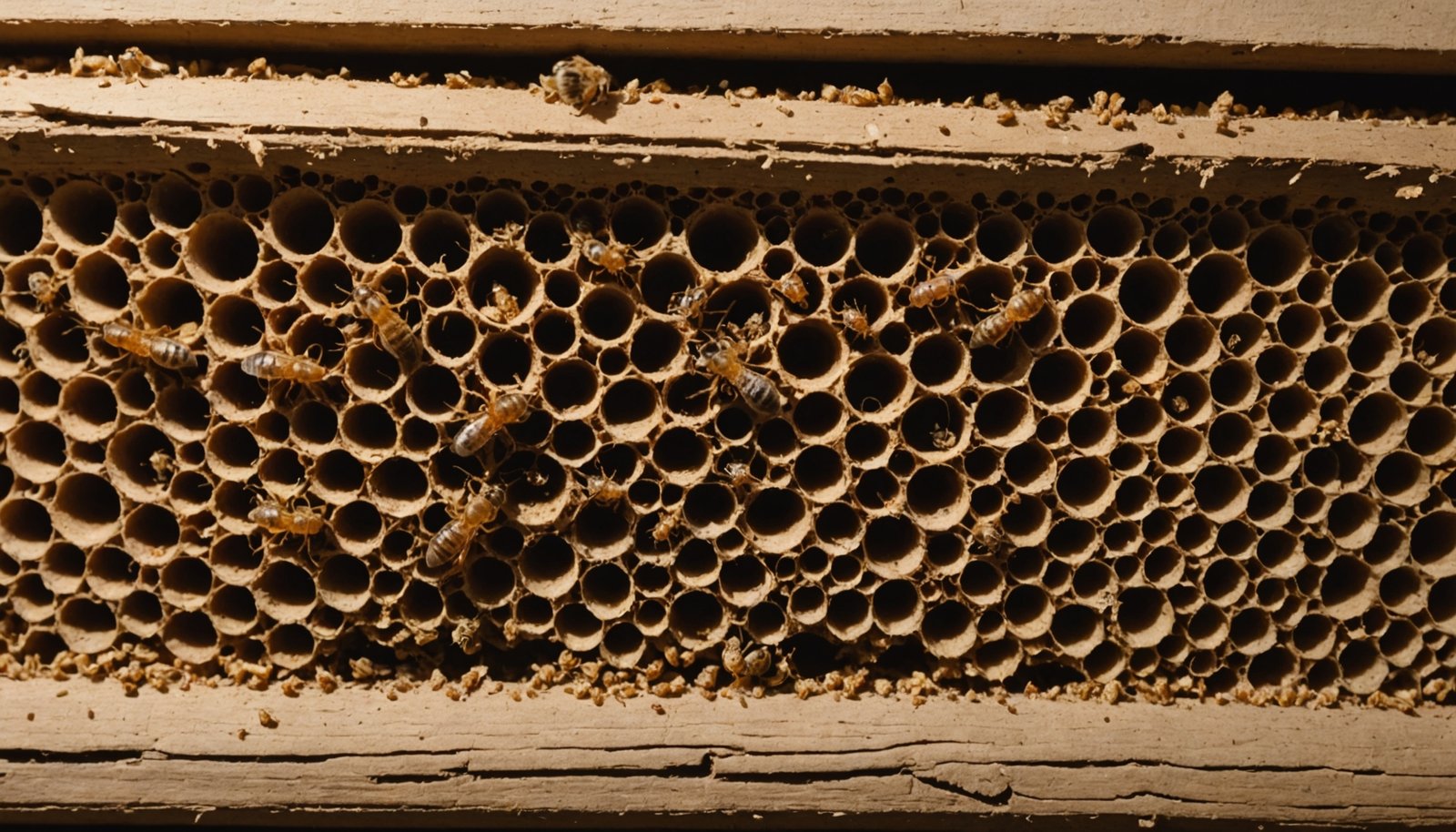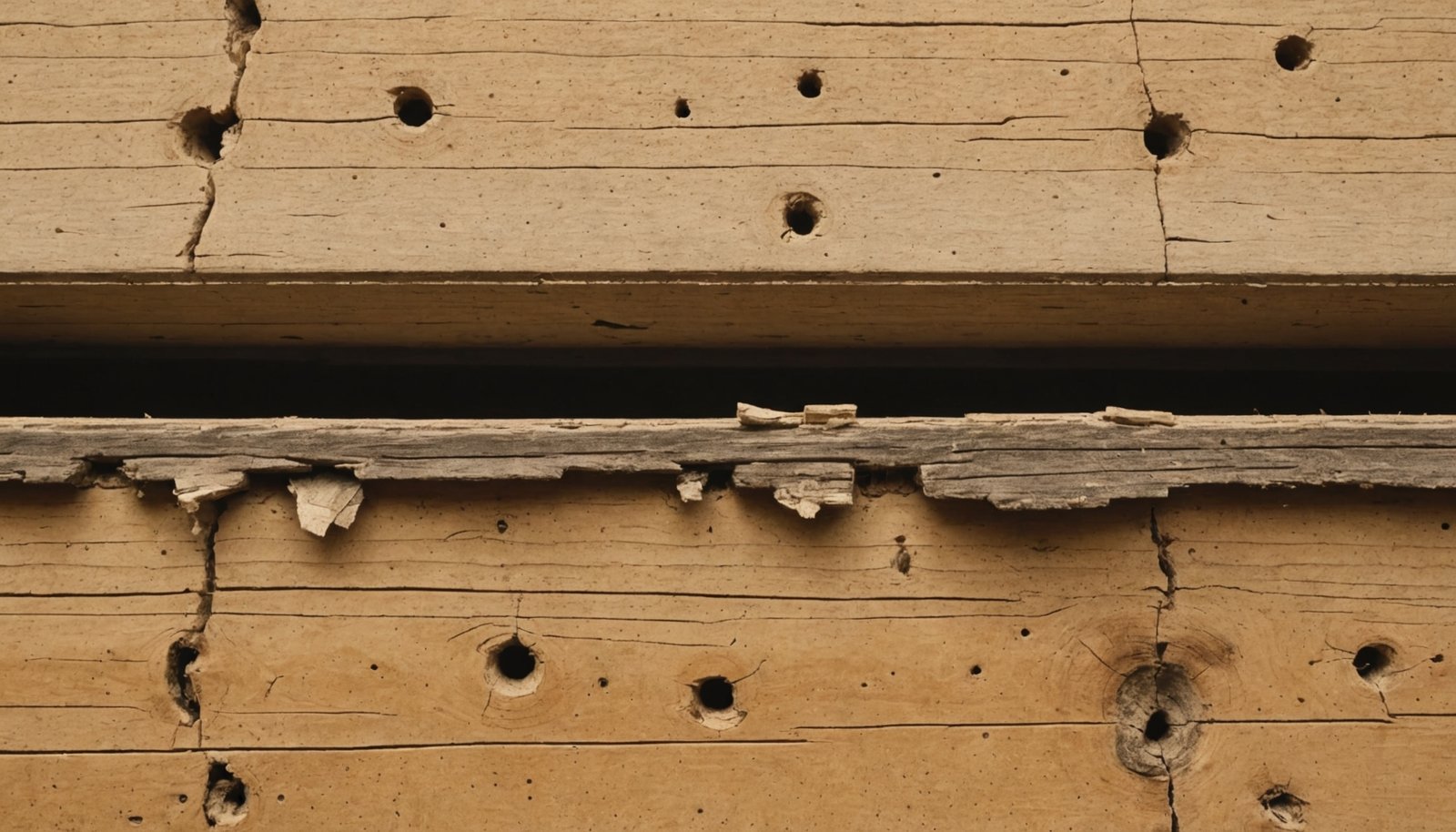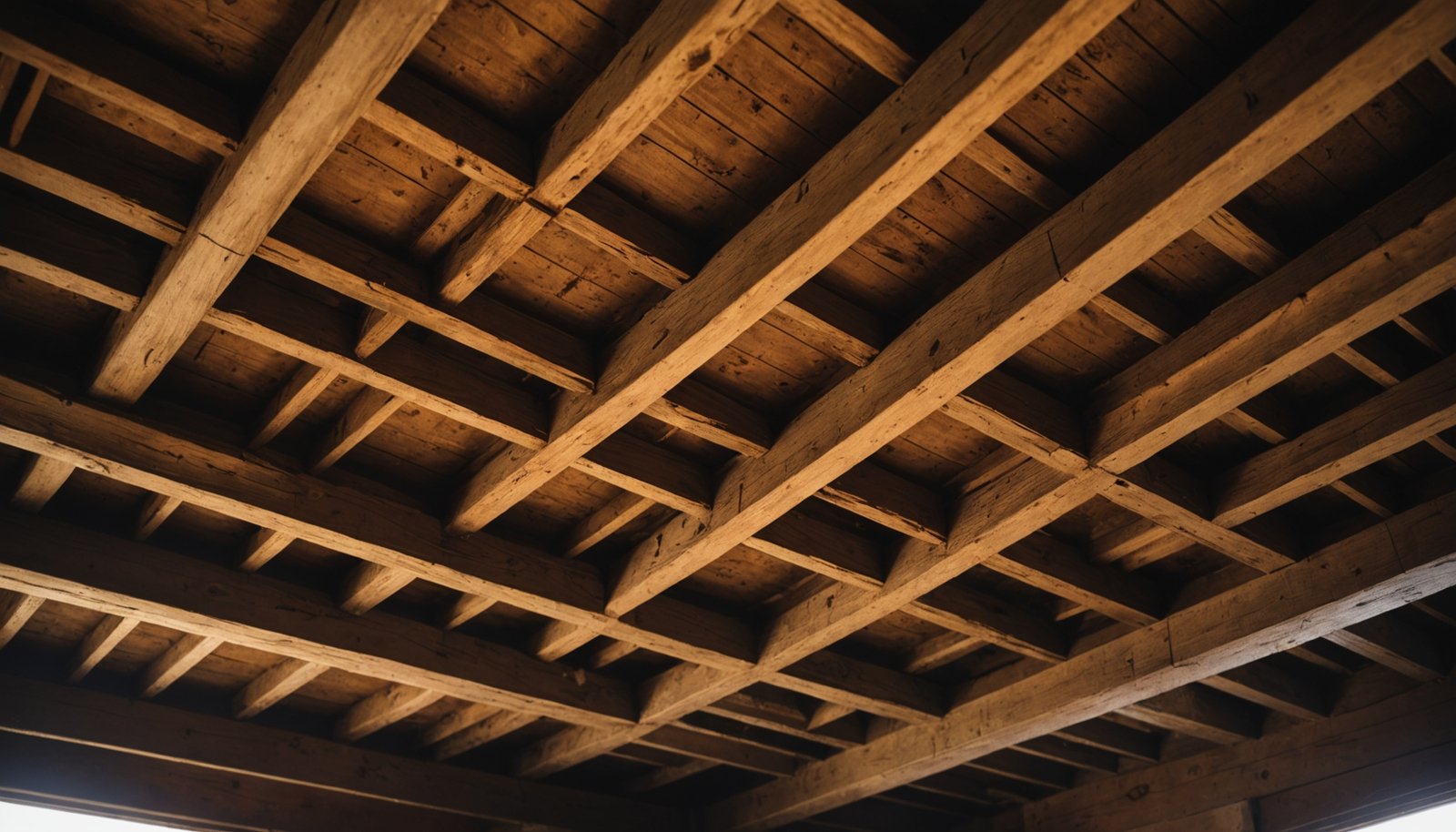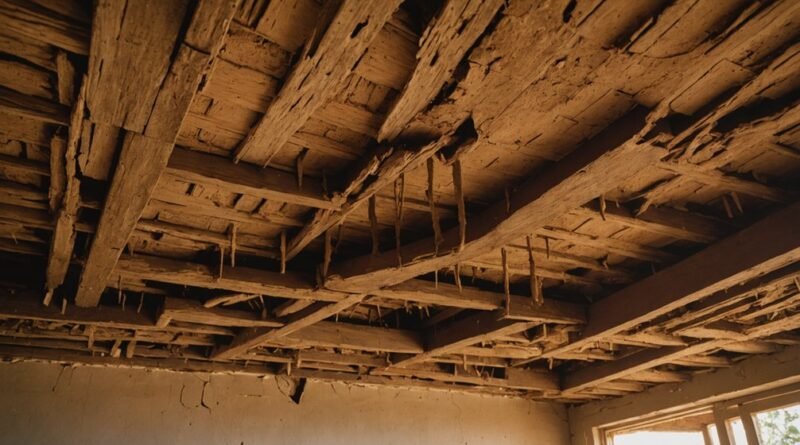Signs of Termites in Walls, Floors, and Ceilings
You’ll spot termite infestations through key warning signs in your home’s surfaces. Watch for tiny pinholes, bubbling paint, and hollow sounds when tapping walls. Check floors for soft spots, squeaking, or uneven areas that feel spongy underfoot. In ceilings, look for sagging spots, paint discoloration, and sawdust-like droppings in corners. While these signs help identify problems, understanding the full scope of termite damage requires deeper investigation.
Key Takeaways
- Hollow sounds when tapping walls, floors, or ceilings indicate termites have eaten through the wooden structure inside.
- Paint bubbling, peeling, or discoloration on surfaces often reveals moisture from termite activity beneath.
- Small pinholes in drywall or wallpaper are entry points where termites have bored through the surface.
- Sagging or uneven floors with soft spots signal compromised structural integrity from termite feeding damage.
- Frass (termite droppings) resembling sawdust accumulates near wooden structures and indicates active infestation.
Common Signs of Termite Wall Infestations

When your walls start showing subtle changes, termite infestations might be to blame.
You’ll want to look for tiny pinholes in your drywall or wallpaper, as these are clear signs of termite damage where they’ve burrowed through. If you notice bubbling or peeling paint, it’s often due to moisture from termite activity that’s compromising your wooden structures.
Try tapping on your walls – if you hear a hollow sound, it could indicate that termites are eating away at the interior.
Watch for faint lines or tunnels on your drywall, which reveal termite galleries they’ve created while feeding.
Don’t forget to conduct regular inspections of your baseboards and walls, looking for discolored drywall or crumbling areas.
Early detection of these warning signs can prevent extensive damage to your home.
Identifying Floor Damage and Structural Concerns

Your floors can reveal serious termite problems through sagging areas and soft spots that develop when these pests hollow out support beams and joists.
You’ll notice uneven surfaces, excessive squeaking, or a spongy feeling underfoot as termites weaken the structural integrity of your flooring system.
What’s particularly concerning is that visible floor damage often indicates extensive hidden destruction beneath the surface, where termites have already compromised critical support structures.
Sagging and Support Issues
Among the most serious signs of termite infestation, structural damage to floors and support systems can signal extensive colony activity beneath your home.
You’ll need to watch for compromised structural integrity in your living spaces, as termite damage often leads to sagging floors and unstable support beams. Early detection through regular inspections can help prevent catastrophic structural failures.
- If you notice your floors feeling “spongy” or “springy” when walking, you’ve likely got termites consuming wood from within.
- Check for doors and windows that won’t open or close properly due to warped frames.
- Look for sagging ceilings, which indicate compromised load-bearing elements.
- Remember that termites work quickly – a single colony can destroy significant portions of wood supports in just months.
Hidden Structural Weaknesses
Discovering hidden structural damage from termites requires careful attention to subtle warning signs throughout your home.
When you notice blistering floors, sagging spots, or areas that feel spongy underfoot, you’re likely dealing with compromised structural integrity from an active infestation.
You can detect a termite problem by tapping on wood surfaces – if they sound hollow, it’s a clear indication of internal feeding damage.
Don’t ignore sticking doors or windows, as these could signal warping from termite tunneling.
Regular termite inspections are essential since these pests can consume significant amounts of wood in just months.
Watch for cracking ceilings and buckling floorboards, as these signs often reveal extensive damage that’s already occurred beneath the surface.
Warning Signals in Ceiling Areas

Inspecting ceiling areas for termite damage requires careful attention to visual and auditory clues that could signal an infestation. When you’re checking for Signs of Termites, examine your ceilings carefully for any indication of compromised structural integrity.
Early detection can save you from extensive repairs and costly damage.
- Look for cracks or sagging areas that suggest termites have tunneled through support beams.
- Watch for paint discoloration or bubbling in drywall, which often indicates moisture from termite activity.
- Check corners and molding for frass – termite droppings that look like sawdust.
- Tap ceiling panels to listen for hollow sounds, as this can reveal internal wood damage.
If you notice any of these warning signs, don’t wait to take action. Termite damage worsens quickly, and addressing the problem early is essential for protecting your home.
Hidden Termite Activity Behind Surfaces
While termites often work silently behind walls and surfaces, their destructive activity leaves subtle yet telling signs that homeowners should recognize.
You’ll notice small pinholes appearing in your drywall or wallpaper, indicating where these pests have been feeding. When you tap on wooden surfaces, listen for hollow sounds that suggest hidden termite activity beneath.
Watch for bubbling or peeling paint, as this signals moisture problems from termites compromising your walls’ structural integrity. Signs of a termite infestation may also include discolored or sagging areas where wood supports have been damaged.
Don’t wait until you see obvious termite damage – early detection through regular professional termite inspection is essential. By the time visible damage appears, these destructive insects may have already caused significant harm to your home’s structure.
Professional Inspection and Detection Methods
Professional termite inspectors use specialized equipment like moisture meters and infrared cameras to find hidden colonies that you can’t spot on your own.
You’ll see them carefully examine walls, floors, and ceilings for telltale signs like hollow wood and frass deposits that indicate active infestations.
Their trained expertise allows them to analyze subtle warning signs and develop targeted treatment strategies based on the specific termite species and damage patterns they identify.
Advanced Detection Equipment Used
Modern termite detection relies heavily on sophisticated equipment that revolutionizes how inspectors locate and assess infestations.
You’ll find that advanced detection technology has made it possible to identify hidden infestations before they cause extensive damage to your property.
- Infrared cameras detect temperature differences in walls, revealing moisture spots and insulation disturbances that signal termite activity.
- Acoustic sensors pick up the subtle sounds of termites tunneling through wood, helping pinpoint active colonies.
- Moisture meters measure wood’s water content, identifying conditions that attract termites.
- Borescope cameras allow visual inspection inside walls without causing damage, providing clear evidence of infestations.
These tools work together to create a thorough inspection process, ensuring that no termite colony goes undetected in your home’s structure.
Common Visual Inspection Areas
Several key areas demand close scrutiny during a visual termite inspection of your home.
You’ll want to check your walls and foundation for mud tubes, which are telltale signs of termite movement. Pay attention to any discoloration or bubbling in your wall paint, as these changes often indicate moisture from termite activity.
Listen for hollow-sounding wood when tapping walls, floors, and ceilings, as this reveals where termites have eaten through the interior. Look for termite droppings, known as frass, which resemble sawdust near infested areas.
Don’t ignore sticking doors and windows – if they’re becoming harder to open or close, it could mean termites are causing structural warping within your walls.
Trained Expert Analysis Methods
While homeowners can spot obvious signs of termite activity, trained experts employ sophisticated detection methods that reveal hidden infestations.
Professional pest control specialists use advanced tools like moisture meters and infrared cameras to identify concealed termite colonies within your walls, floors, and ceilings. You’ll benefit from their trained eye and specialized equipment to detect subtle indicators that might otherwise go unnoticed.
- Experts use moisture meters to measure dampness levels that could attract termites
- Infrared cameras reveal hidden termite damage by detecting temperature variations behind surfaces
- Trained inspectors recognize subtle signs like frass deposits and discarded wings near entry points
- Many companies offer free assessments to evaluate your home’s risk factors and create targeted treatment plans
Early Warning Signs vs. Advanced Damage
Before termites cause catastrophic structural damage to your home, they often leave subtle clues that shouldn’t be ignored. Early warning signs include small pinholes in your drywall, bubbling paint, and mud tubes along walls where termites search for food sources.
If you spot these indicators, you can address the infestation early before significant damage occurs.
Advanced damage is far more serious and costly. You’ll notice hollow-sounding wood when tapped, crumbling baseboards, and compromised structural integrity.
A large colony can devour 2 feet of a 2×4 in just five months, leading to sagging floors and warped door frames.
Don’t wait until you see severe damage – inspect your home regularly for frass, termite wings, and other warning signs to protect your property from these destructive pests.
Prevention and Monitoring Strategies
Taking proactive measures can help you avoid the costly damage of termite infestations. Regular monitoring of your walls, floors, and ceilings for signs of termite activity is essential for effective prevention.
You’ll want to establish a thorough termite control strategy that includes professional inspections and maintaining proper home conditions.
- Check for frass accumulation near wooden structures and investigate any hollow sounds when tapping surfaces
- Keep your home’s exterior free of wood debris and store firewood away from the building
- Confirm proper ventilation throughout your home to prevent moisture buildup that attracts termites
- Schedule annual professional inspections to assess your property and implement preventative measures before infestations occur
Conclusion
You’ll need to act quickly if you spot any signs of termite activity in your home’s walls, floors, or ceilings. Don’t ignore hollow-sounding wood, bubbling paint, or tiny mud tubes. Schedule regular professional inspections, maintain proper moisture control, and keep wood away from your foundation. Remember, early detection and prevention are your best defenses against costly termite damage.

